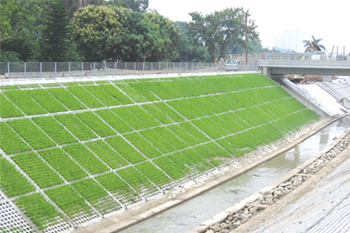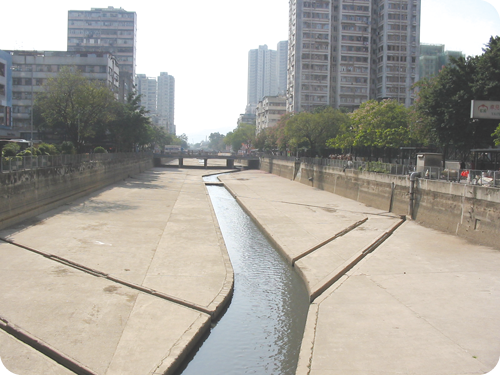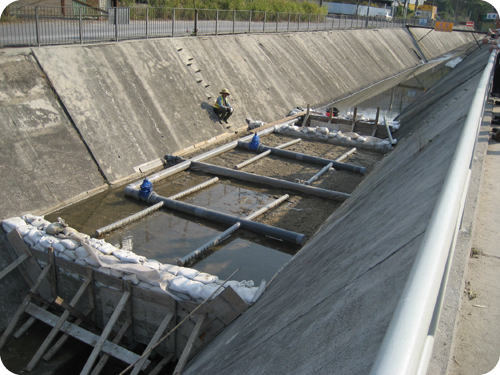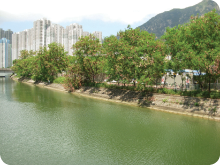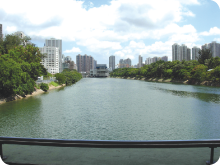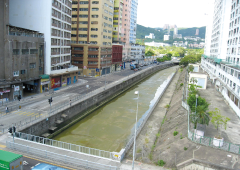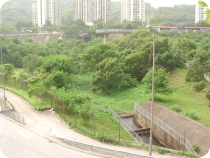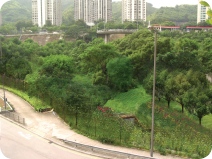| Overview | |||||||||||||||||||||||||||||
DSD continues to enhance the stormwater drainage systems in Hong Kong for protecting the public against flooding. DSD has been implementing a $11.6 billion flood prevention programme in the New Territories (NT) for river training woks and village flood pumping schemes, and an $8.5 billion programme of urban drainage improvement works to substantially raise the standard of flood protection. Since 1997, about 73 km of rivers in the northern parts of NT have been trained with 27 village flood pumping schemes in operation. The risk of regional flooding in the NT has improved. In urban areas, the major construction projects of two drainage tunnels in Hong Kong West and Tsuen Wan commenced in late 2007 for completion in 2012. These projects aim to divert run off from upland catchments preventing it from entering the congested urban areas. By completion of these projects, we expect the protection against flooding in urban areas will be further enhanced. In early 2008, we have also commissioned a Review of the Drainage Master Plans (DMPs) in Yuen Long and Northern Districts to further improve the local flooding in upstream villages and deficiencies due to new developments. Besides the nullah decking projects, the studies on rehabilitation of Yuen Long Town Nullahs and beautification works for Tuen Mun River Channel are two major environmental/landscaping improvement projects undertaken for the existing river channels during the year. |
|||||||||||||||||||||||||||||
Flooding Incidents in 2007 2007 was a relatively dry year. The annual rainfall of about 1 707 mm was about 23 per cent below the normal yearly rainfall of 2 214 mm. Only two tropical cyclones, namely Severe Tropical Storm Pabuk and Tropical Storm Francisco, affected Hong Kong. Among them, Pabuk necessitated the issuance of the first No. 8 Gale or Storm Signal and brought heavy showers. The total rainfall of August was 488 mm, 97 mm above normal. In 2007, no Black Rainstorm Warning Signal was issued while only 12 and 2 times Amber and Red Rainstorm Warning Signals were issued respectively. Under the influence of active troughs of low pressure and southerly airstream, June was wetter than usual. The monthly rainfall of 490 mm was about 30 per cent above normal. On June 10, a trough of low pressure brought unsettled weather to the coastal areas of Guangdong. Heavy thundery showers brought more than 100 mm rainfall to most parts of the territory. In the northwestern part of the NT/Lantau Island, a rainfall exceeded 100 mm per hour was recorded by the Hong Kong Observatory. Local flooding occurred at some low-lying areas. Since 2007 was rather dry, no serious flooding was observed from all flooding blackspots, including the low-lying Wing Lok Street in Sheung Wan. For this flooding blackspot, DSD continued providing a special messaging service (namely the Sheung Wan Flood Watch) to alert residents and shopkeepers in Sheung Wan area by sending SMS or voice messages about possible flooding under Rainstorm Warning Signals, Typhoon Signals or high tide condition. DSD will continue the operation of the Flood Watch until the completion of all long-term mitigation measures, including intercepting drains and stormwater pumping station. |
|||||||||||||||||||||||||||||
Flood Prevention in NT To solve the flooding problem and to improve the drainage system in NT, DSD has been implementing a series of major flood control projects at a total estimated cost of over $11.6 billion. |
|||||||||||||||||||||||||||||
Flood Prevention in Northern NT (NNT) and
Those flood prevention projects in the NNT and NWNT can broadly be classified into two main types, namely drainage channels to collect and convey floodwater to the sea, and village flood pumping schemes to protect villages in low-lying areas. All planned 27 village flood pumping schemes to remove 35 low-lying villages from high flood risks were completed. Now, over 240 hectares of low-lying village area with a population of 30 000 people are being protected. DSD has implemented a number of drainage works to improve the serious flooding in Lo Wu, Ho Sheung Heung, Yin Kong and Tin Ping Shan. These projects cost approximately $4.1 billion and over 70 per cent of the planned drainage works have been completed. In 2008, drainage improvement works along Ma Wat River in NNT was substantially completed. The level of protection against flooding at Kau Lung Hang has been raised. In the past, most areas in Tin Shui Wai, Yuen Long and Kam Tin in NWNT were susceptible to flooding. The situation has been greatly improved by the drainage improvement works carried out by DSD in the past 20 years. The projects in NWNT costing approximately $5.0 billion are over 85 per cent completed. The last main drainage channel, Yuen Long Bypass Floodway, was completed in late 2006. The flooding risk at flooding blackspots such as Tai Kiu Tsuen and Tai Kei Leng was reduced. We will continue to carry out drainage improvement works in secondary and tertiary drainage channels at upstream of NWNT basins. |
|||||||||||||||||||||||||||||
DMP Review Study for NNT and NWNT With the continuous development and urbanization of the NT, it is necessary for the Government to formulate a comprehensive strategy for the overall land drainage and flood control. For NNT and NWNT, the DMP Studies for the Yuen Long and the NNT were completed in 1998 and 1999 respectively. The majority of the improvement and river training works recommended in the Studies have been implemented and relieved most of the regional flooding problems. Since the completion of the DMP Studies, there have been major changes in the land uses. New development proposals and town planning studies have also been commissioned. In addition, local flooding cases have also been recorded during the past few years in the Yuen Long and North Districts, indicating that further improvement to the drainage systems is required. In this regard, DSD commissioned a Review of the DMPs in Yuen Long and North Districts in late March 2008 for completion in 2010. |
|||||||||||||||||||||||||||||
Rehabilitation of Yuen Long Town Nullahs The existing nullah at Yuen Long Town with concrete lining was constructed more than 40 years ago. Its appearance is dull and improvement is desirable. DSD has commissioned a consultancy study in January 2007 to examine various options and proposals to improve the appearance and enhance the ecological value of the nullah. The drainage performance of the existing nullah and the flood risks of various improvement options were assessed.
Our consultants also implemented some trial rehabilitation works during the dry season in early 2008 to test the effectiveness of some water quality improvement measures. We will work closely with the District Council and concerned green groups to develop a scheme that would as far as possible meet the expectation of the locals, improves the environment and enhances the ecological value of the nullah. |
|||||||||||||||||||||||||||||
Beautification Works for Tuen Mun River Channel In the 2007 Policy Address, the Government decided to beautify Tuen Mun River Channel. Hong Kong Housing Society has engaged consultants to formulate a preliminary revitalization framework to enhance, beautify and revitalize the Tuen Mun River. DSD will assist by providing drainage advice. In addition, DSD is studying different methods to beautify the embankment of the River Channel.
|
|||||||||||||||||||||||||||||
Flood Prevention in Urban Area Flood prevention in urban area mainly involves the improvements of the flow capacity of the existing stormwater drainage networks for better performance in collection and conveyance. Under some special circumstances, innovative methods such as flood storage, flood pumping or flow diversion through drainage tunnels are used to minimize the extent of works that may cause disturbances to traffic or conflict with underground utilities. |
|||||||||||||||||||||||||||||
|
|||||||||||||||||||||||||||||
|
|||||||||||||||||||||||||||||
